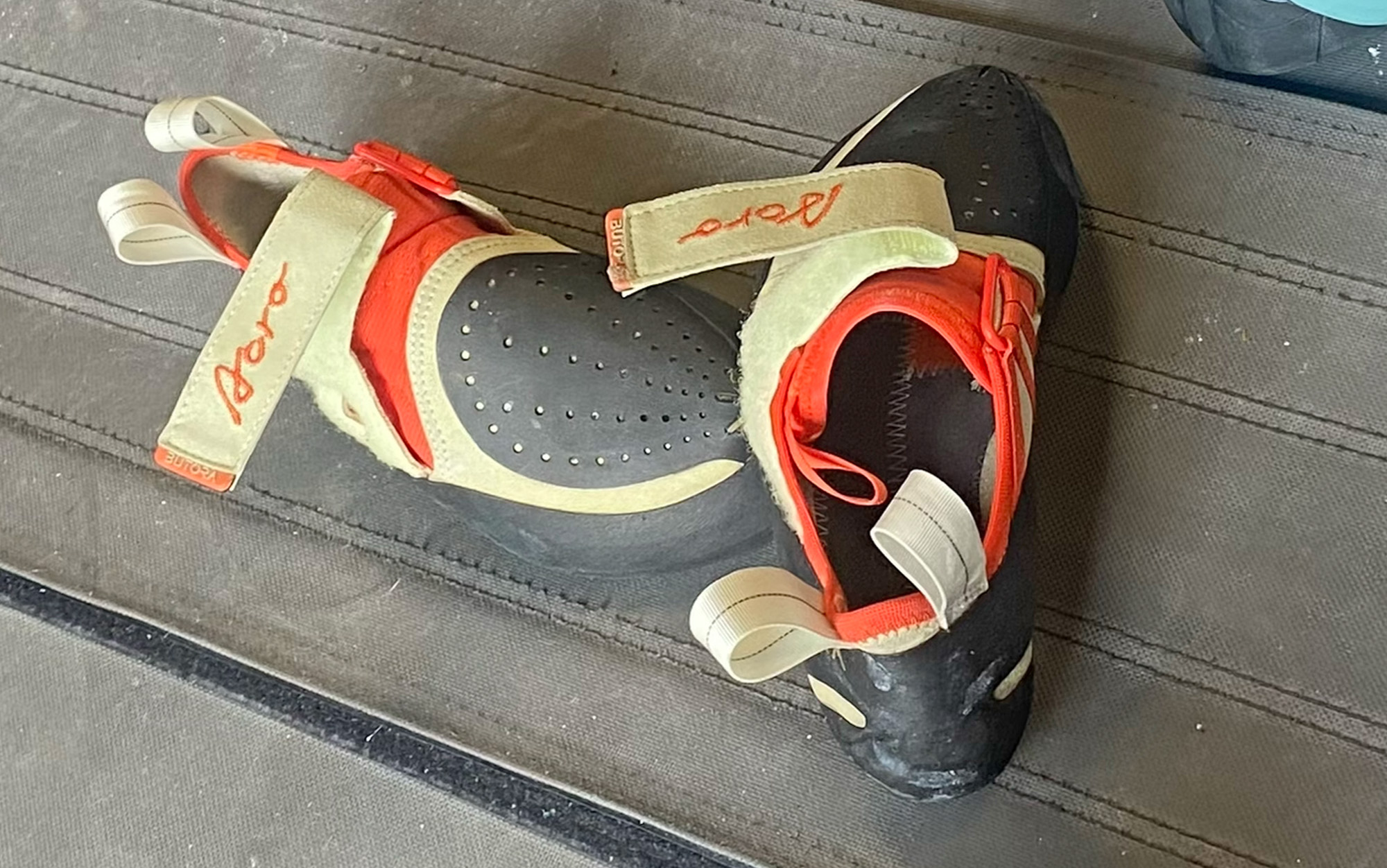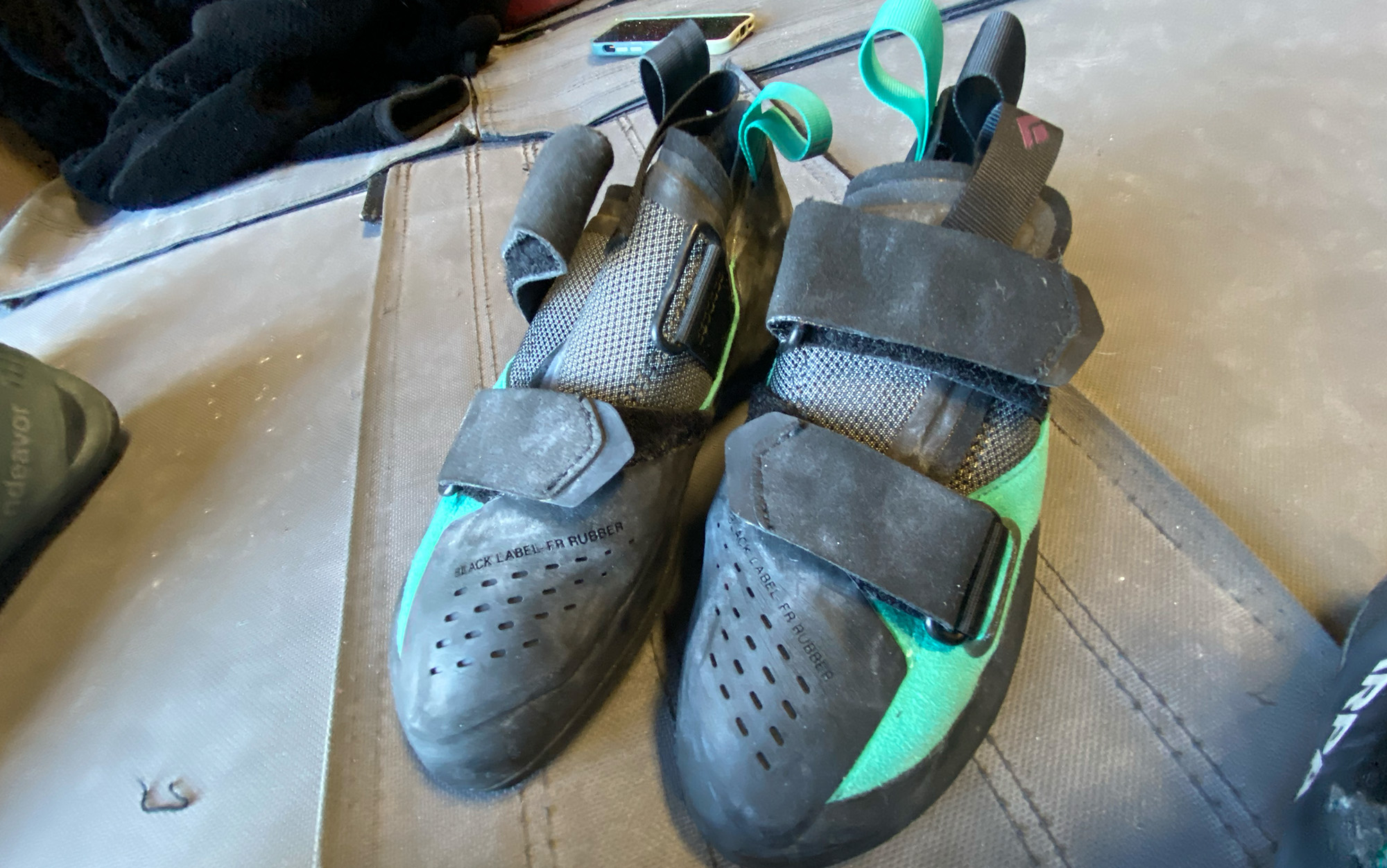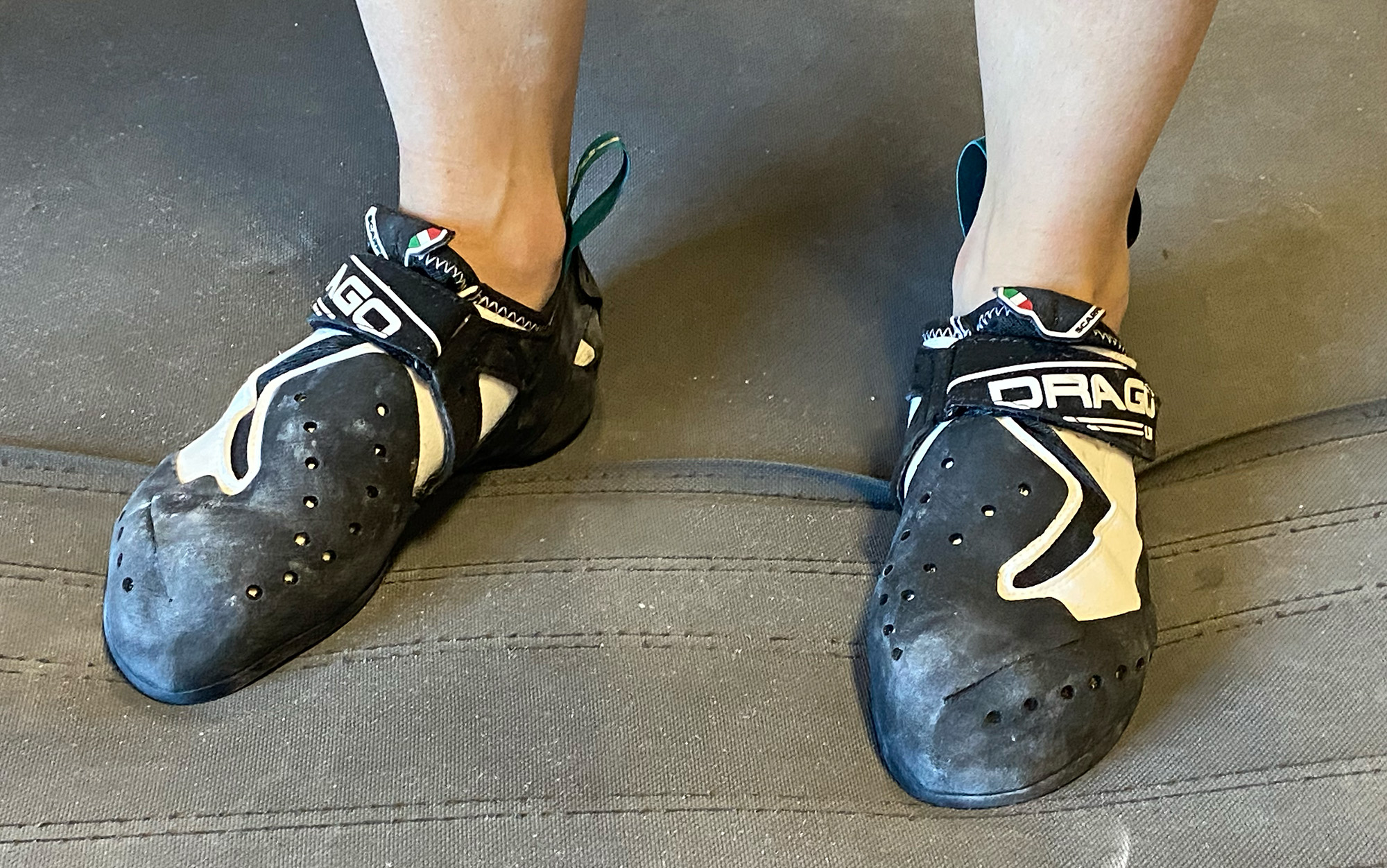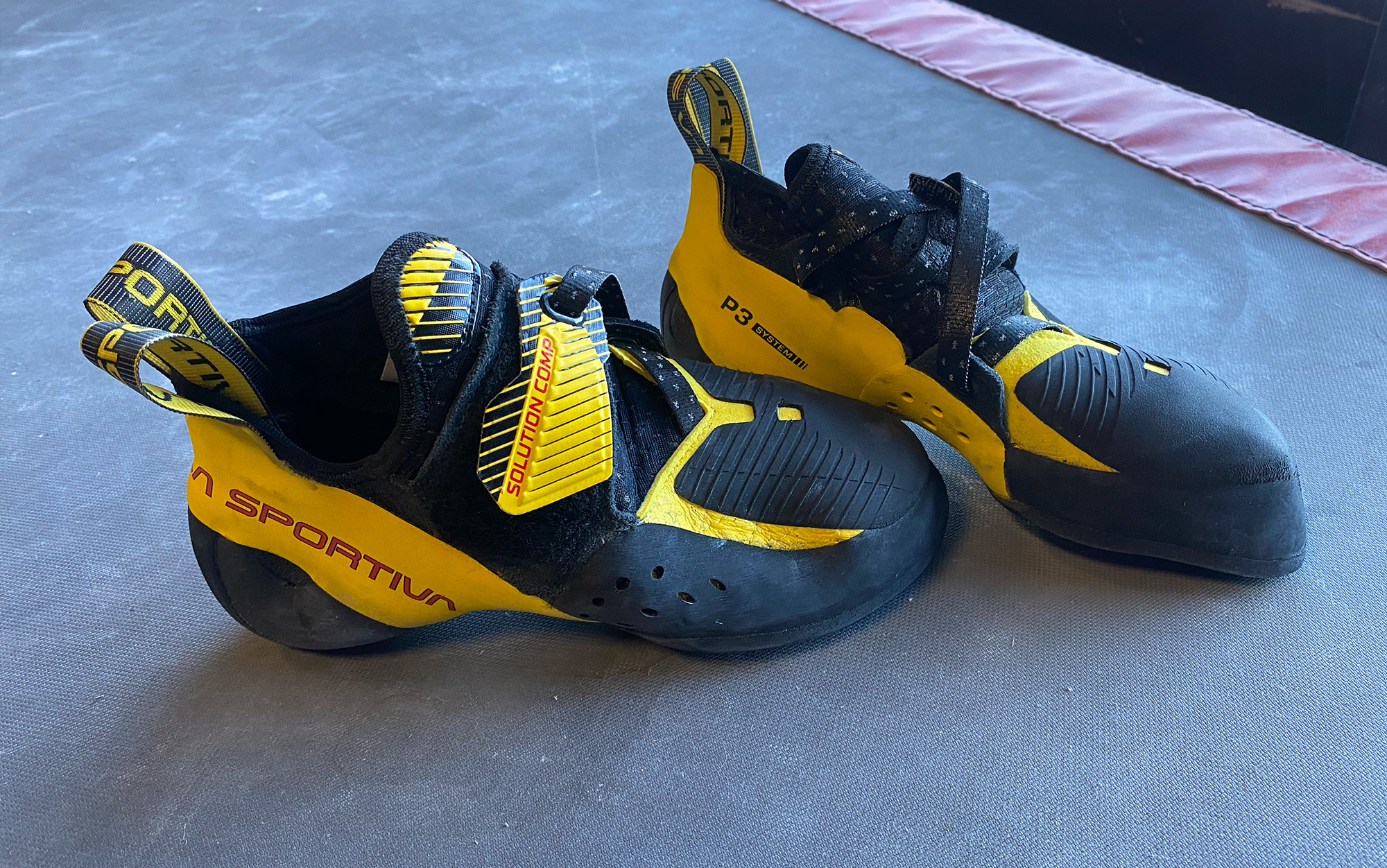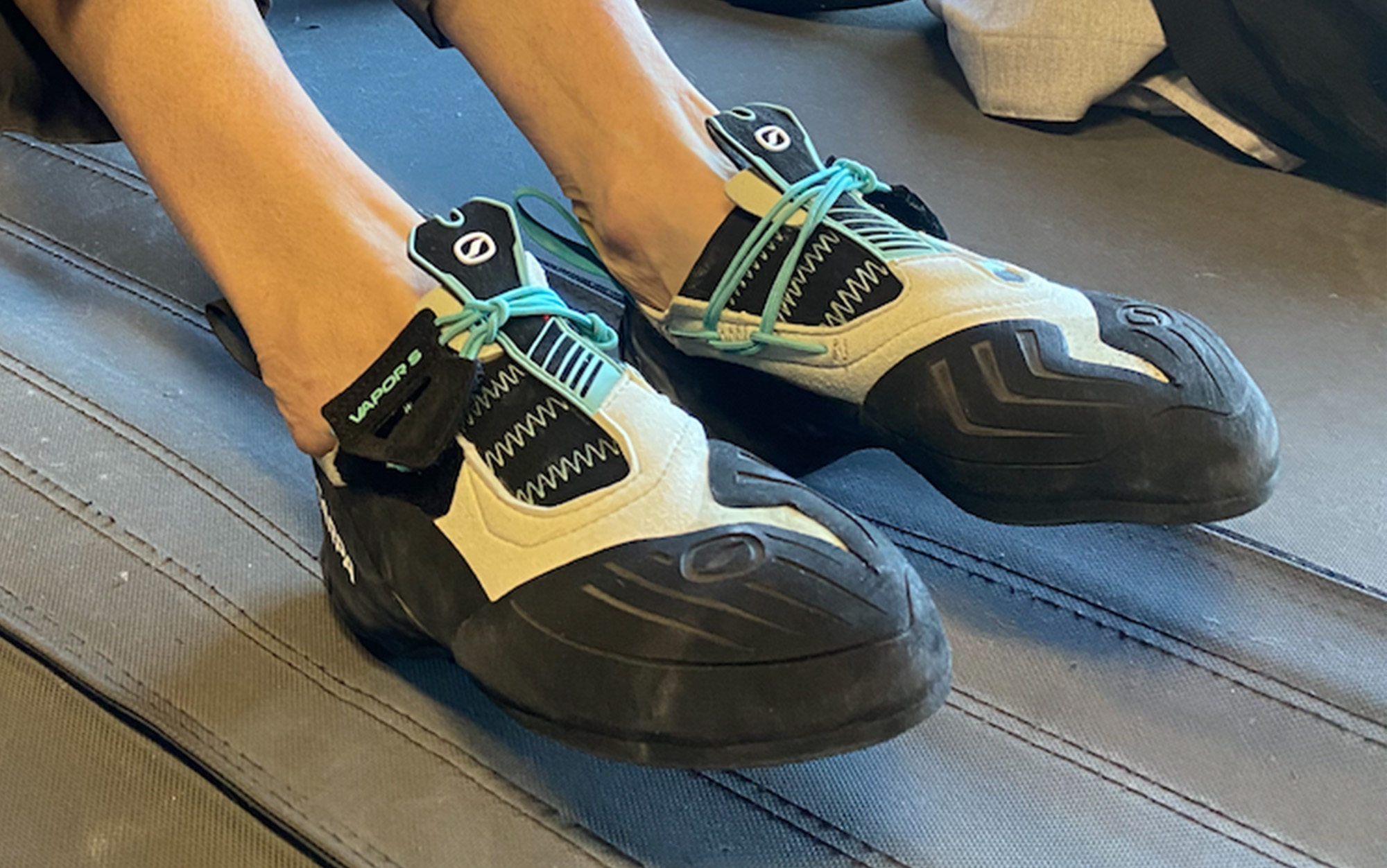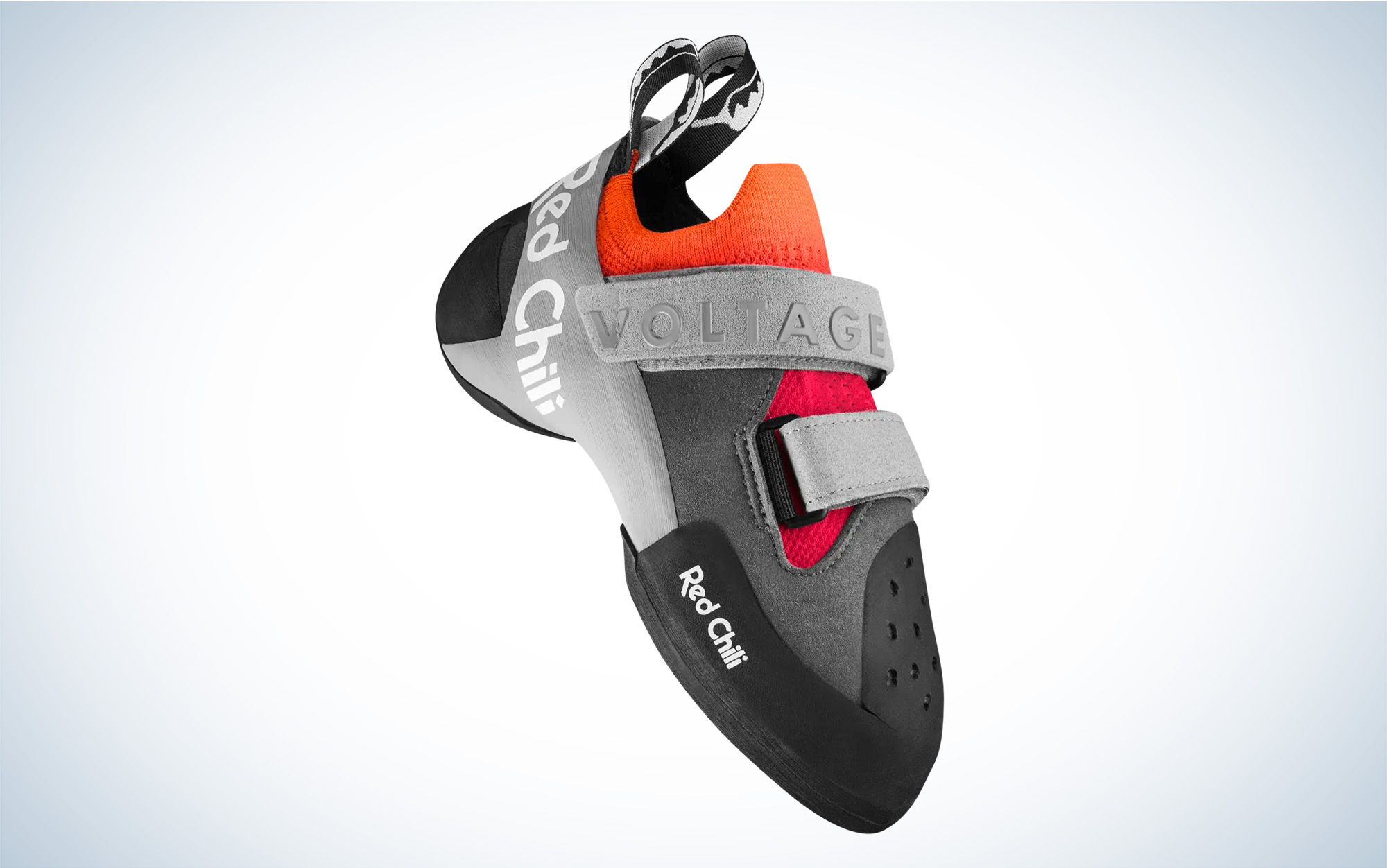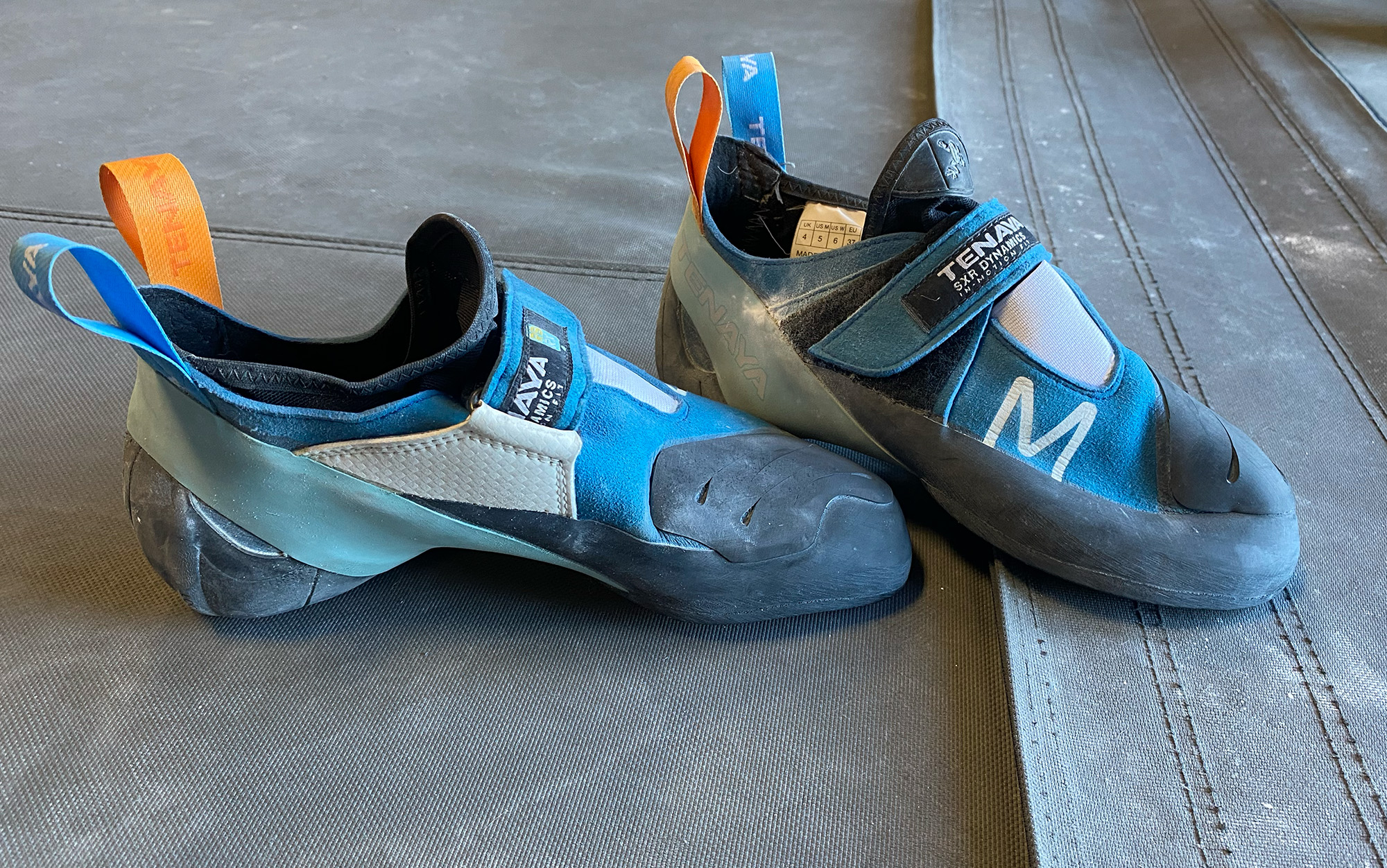We may earn revenue from the products available on this page and participate in affiliate programs. Learn More ›
Upgrading your climbing shoes is one of the best ways to accelerate your performance. That’s especially true if you’re looking to level up from beginner or intermediate routes to more advanced grades. Most novice climbers start with neutral, flat-soled shoes, which let you stand flat on the ground without forcing your foot into a downturn. These are great for all-day comfort but lack the precision and power that a stiffer, more aggressively curved model can provide.
That said, choosing the right shoe isn’t as easy as waltzing into a shop and grabbing the first downturned shoe you see. In fact, the more advanced your climbing gets, the more varied — and specialized — your shoe options become. Are you looking for a soft bouldering shoe that you can paste to tiny edges, or a stiff sport shoe that will help maximize your reach? Do you plan to climb steep, overhung sport routes, or low-angle slabs? To help you zero in on your needs, I put together this guide. Here’s how to choose the best climbing shoe for you.
How We Tested the Best Climbing Shoes
Believe me when I say, this was quite the process. First, I selected two dozen of the most popular shoe models from top manufacturers. Then, I selected 10 testers from a variety of climbing backgrounds — from serious competition climbers to veteran outdoor climbers. For two months, we took turns testing the shoes both indoors and out. At the end of the testing period, I pored over each testers’ notes, chose the highest-ranking models, and distilled my findings into the comprehensive reviews below.
Best Climbing Shoes: Reviews & Recommendations
Most Comfortable: Ocun Jett QC
Key Features
- Weight: 13 ounces
- Upper Material: Synthetic
- Rubber: CAT 1.5
- Shape: Slightly downturned, moderately asymmetrical
Pros
- Great balance of performance and comfort
- Minimal break-in time
- Affordable price
- Leather sole minimizes odors
- Great choice for newer climbers looking to level up
Cons
- Not as aggressive as other models
- Wider-footed testers found the narrow fit uncomfortable
No matter what we threw at the Ocun Jett QC — hard sport climbing, gym bouldering, and long gym sessions — we never grew tired of wearing them. The Jett QC perfectly mimics the shape of the foot, reducing strain and foot fatigue. The relatively stiff midsole let us stand on tiny edges and maximized reach when we were on our tippy toes — something shorter testers appreciated.
The heel cup was snug enough that even narrow-footed testers were able to heel hook without shifting or sliding. Ocun’s CAT 1.5 rubber also earned top marks; we found it sticky and reliable, even on tiny nubbins and greasy gym holds. The only downside is because this shoe maximizes comfort, it’s not as aggressively downturned as other models on this list. That made it our go-to for vertical sport climbing — but not for overhung routes.
Best for Jumping Grades: Butora Acro
Key Features
- Weight: 1 pound, 1 ounce (per pair)
- Upper Materials: Synthetic, leather
- Rubber: NEO Fuse
- Shape: Moderately downturned, very asymmetrical
Pros
- Precise, aggressive construction ideal for technical footwork and steep terrain
- Stiff midsole provides support, forestalling foot fatigue on long routes
- Comes in narrow and wide versions
- Reasonable price point
- Easy to slip on and off
Cons
- Too aggressive to smear well
- Single strap and sock-like tongue make it tough to finetune fit
Aggressively downturned, yet comfortable out of the box, the Butora Acro is my top pick for beginner or intermediate climbers looking to make the leap into more serious grades. A stiff midsole provided plenty of support and power on small edges outdoors, and we loved the aggressive downturn for clawing our way up steep climbs in the gym.
Bouldering testers also appreciate the extra rubber on the heel and toe, which boosted confidence while heel- and toe-hooking. One small complaint: There’s only one strap, which makes it slightly harder to dial in a precise fit. You can adjust the fit by tightening the strap at various angles thanks to a wide velcro closure system.
Best Value: Black Diamond Method
Key Features
- Weight: 15 ounces
- Upper Material: Synthetic
- Rubber: Black Label Fuse
- Shape: Moderately downturned, very asymmetric
Pros
- More affordable than many other models
- Minimal break-in time
- Tensioned heel hugs the foot and doesn’t shift, providing security while heel hooking
- Moderate stiffness provides support on longer sport climbs
Cons
- Proprietary rubber not as sticky as some other models
- Runs small, which makes it difficult to get the right size
- Not as comfortable as some other models
While this wasn’t the least expensive shoe we tested (the Ocun Jett QC takes that prize), the Black Diamond Method provides a great balance of price, aggressiveness, and durability — which means it’s likely to stick with you as you progress through the grades. That makes it a great value and a long-term investment that you probably won’t have to replace just a season or two down the line.
While this shoe has a lot to commend it, we loved it most for techy sport routes with tiny edges. It performed well on both moderate overhangs and on long, vertical routes. Our only complaint was fit. The Method seems to run quite small, and testers with bonier heels found the shape of the heel cup uncomfortable.
Read my story on the best beginner climbing shoes to read about more value and beginner options.
Best for Bouldering: Scarpa Drago LV
Key Features
- Weight: 14 ounces (per pair)
- Upper Material: Synthetic, leather
- Rubber: Vibram XS Grip2
- Shape: Very downturned, very asymmetric
Pros
- Excellent for smearing
- Tensioned heel rubber provides security during heel hooks by hugging tight around the back of the foot
- Full-rubber toe coverage ideal for toe hooks
- Comfortable right out of the box
Cons
- Narrow-footed testers found it slightly loose in the heel
- Soft midsole can lead to foot fatigue on longer routes
If you’re looking for a soft, gummy shoe that will paste onto the tiniest of nubs, the Drago LV is for you. Thanks to its split sole, it’s flexible through the midsole, but still provides a little bit of stiffness under the toes that let testers cling to small edges. On those aforementioned edges, we were pleased to find the rubber grippy and reliable. That’s because it’s Vibram XS Grip2, one of the stickiest rubbers on the market. “They smear like a dream,” said one tester, who recently used the Dragos to send three of her gym-bouldering projects in a row. “They provide tons of sensitivity, and I can feel every foothold.”
The rand of a climbing shoe is the rubber that runs from toe to heel underneath the sole, giving the shoe tension. The Drago LV’s tensioned rand drives power through the toes, and a rubber panel encases the top of the foot — a feature testers appreciated while toe-hooking and scumming on harder boulders. Our only complaint: It’s billed as a low-volume shoe, but still fits normal to wide feet best.
Best for Sport Climbing: La Sportiva Solution Comp
Key Features
- Weight: 1 pound, 2 ounces (per pair)
- Upper Materials: Synthetic, leather
- Rubber: Vibram XS Grip2
- Shape: Very downturned, very asymmetrical
Pros
- Sensitive, tensioned heel ideal for hooking
- Sticky rubber provides outstanding grip
- Moderate downturn performs in a variety of terrain
- Sliding strap makes it easy to dial in fit
- Minimal break-in time
Cons
- Steep price point
- Don’t last as long as more durable models
The Solution Comp provides a perfect balance between power and sensitivity, and we were surprised to find that they handled techy vertical routes just as easily as they clawed up overhung caves. The rubber is phenomenally sticky, and the rubber toe panels and snug heel cup made toe- and heel-hooking a breeze.
“When I was tired on a long climb, I was able to get a high heel hook to rest. The shoe clung to my foot and didn’t budge,” reports one tester. While we felt some foot fatigue on long routes, the soft midsole is worth it. The Solution Comp’s flexibility allows it to jam in cracks, and we appreciated the sensitivity on technical terrain.
Best For Trad Climbing: Scarpa Vapor S
Key Features
- Weight: 14.2 ounces
- Upper Material: Synthetic
- Rubber: Vibram XS Grip2
- Shape: Moderately downturned, moderately asymmetric
Pros
- Soft and comfortable, even in thin cracks
- Snug fit through the arch
- Flexible midsole makes them excellent for maximizing purchase when smearing the sole against the wall
- Sticky, reliable rubber
Cons
- Don’t edge as well as some stiffer models
- Closure straps may wear out quickly, especially with frequent crack climbing
Over two months of testing, the Scarpa Vapor S proved itself a versatile all-arounder capable of withstanding the rigors of traditional climbing. A slim profile and rubber-encased toe made it comfortable and reliable, even when we were jamming thin cracks in Colorado’s Eldorado Canyon.

A soft midsole allows the shoe to suction itself around the foot, and a tensioned rand — the rubber that lines the side of the foot and wraps up around the heel — suctions around the foot and keeps the heel securely in place. While some narrow-footed testers thought the heel cup a little bit baggy, most found it snug and secure — ideal for heel-hooking outdoors and indoors alike. We also appreciated the sticky Vibram XS Grip2 rubber, which gave us extra confidence on glassy knobs and pebbles.
Our biggest beef with this shoe was the closure. The paracord-like strings must be manually tied in knots if you want to adjust the length of the strap. The closure also doesn’t provide the same kind of sliding adjustability that you’ll find on the La Sportiva Solution Comp. Still, once adjusted, the strap seemed to do its job. Overall, we found the Vapor S a comfortable, versatile all-arounder capable of harder sends. One tester summed it up perfectly: “If you could only bring one pair of shoes on a vacay trip, these would fit the bill.”
Best for Narrow Feet: Red Chili Voltage LV
Key Features
- Weight: 1 pound, 1 ounce (per pair)
- Upper Material: Synthetic
- Rubber: Vibram XS Grip
- Shape: Very downturned, very asymmetric
Pros
- Powerful downturn enhances precision while hooking your way up overhanging routes and edging on tiny holds
- Moderate rigidity provides decent support over long routes
- Minimal break-in-time
- Narrow heel and low-volume design ideal for narrow feet
Cons
- Stiff, aggressive downturn gets in the way on low-angle routes and makes it difficult to press your foot against the wall during smears
- Sock-like liner makes it tough to dial in fit
Stiff, aggressive, and powerful, the Voltage LV is a great choice for narrow-footed sport climbers looking to log some serious mileage on steep lines. A stiff midsole keeps the shoe rigid, ideal for toeing into tiny edges. “It was super easy to be precise,” says one tester, who used them for several months of indoor bouldering and sport climbing.
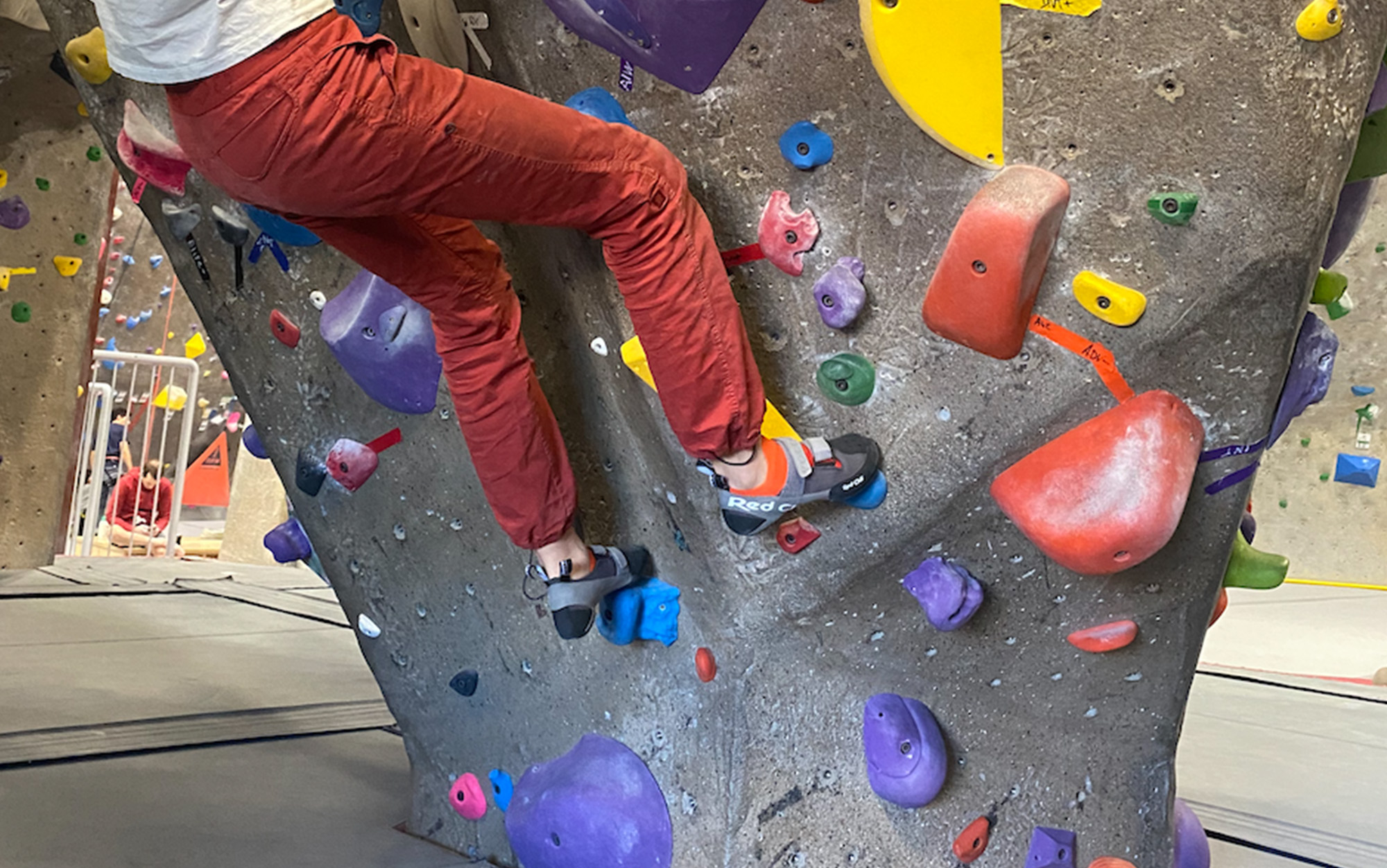
We found the Vibram XS Grip to be both sticky and durable, and the soft materials and asymmetric shape meant they were comfortable right out of the box. That said, the Voltage LV isn’t a perfect fit for all the narrow-footed testers out there. Folks with normal to high arches loved the cozy feel of the sock-like liner, but those with low arches found it felt baggy and tended to bunch up over the top of the foot.
Best for Wide Feet: Tenaya Mastia
Key Features
- Weight: 1 pound, 5 ounces
- Upper Materials: Synthetic
- Rubber: Vibram XS Grip
- Shape: Very aggressive, very asymmetrical
Pros
- Great all-arounder that balances sensitivity with edging power
- Comfortable, secure fit for wide feet
- Sticky rubber provides reliable grip on small holds
- Rubber over the top of the foot supports toe-hooking
Cons
- Not as powerful or aggressive as some of the shoes on this list
- Sock-like liner made it a little tough to get these shoes on and off
Wide-footed testers rejoice: The Tenaya Mastia has arrived. A great all-around shoe with a thoughtful fit, the Mastia quickly became a top pick for long sport routes both indoors and outdoors. “They fit my paddles!” one tester exclaimed, after years of trying to find the perfect wide-footed sport climbing shoe. “They’re particularly comfortable in the toes and widest part of my foot, and they really suction on in all the right places.”
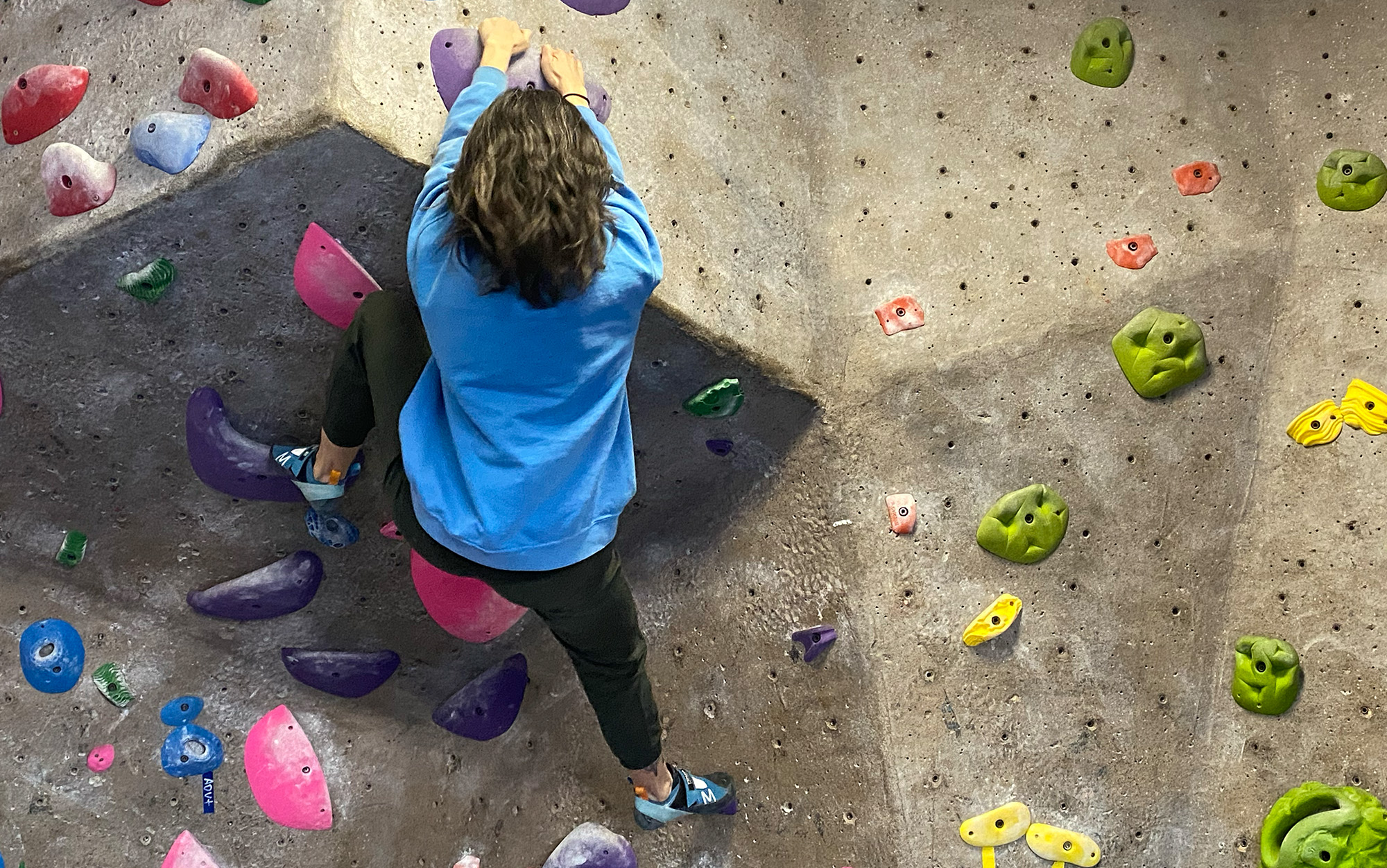
She also found the synthetic materials soft enough to go hard right out of the box (no break-in time required). The biggest downside: While the instep-wrapping mesh tongue was comfortable and breathable, it made it tough to get this shoe on and off quickly.
Read Next: Best Hiking Shoes for Wide Feet
How to Choose the Best Climbing Shoes
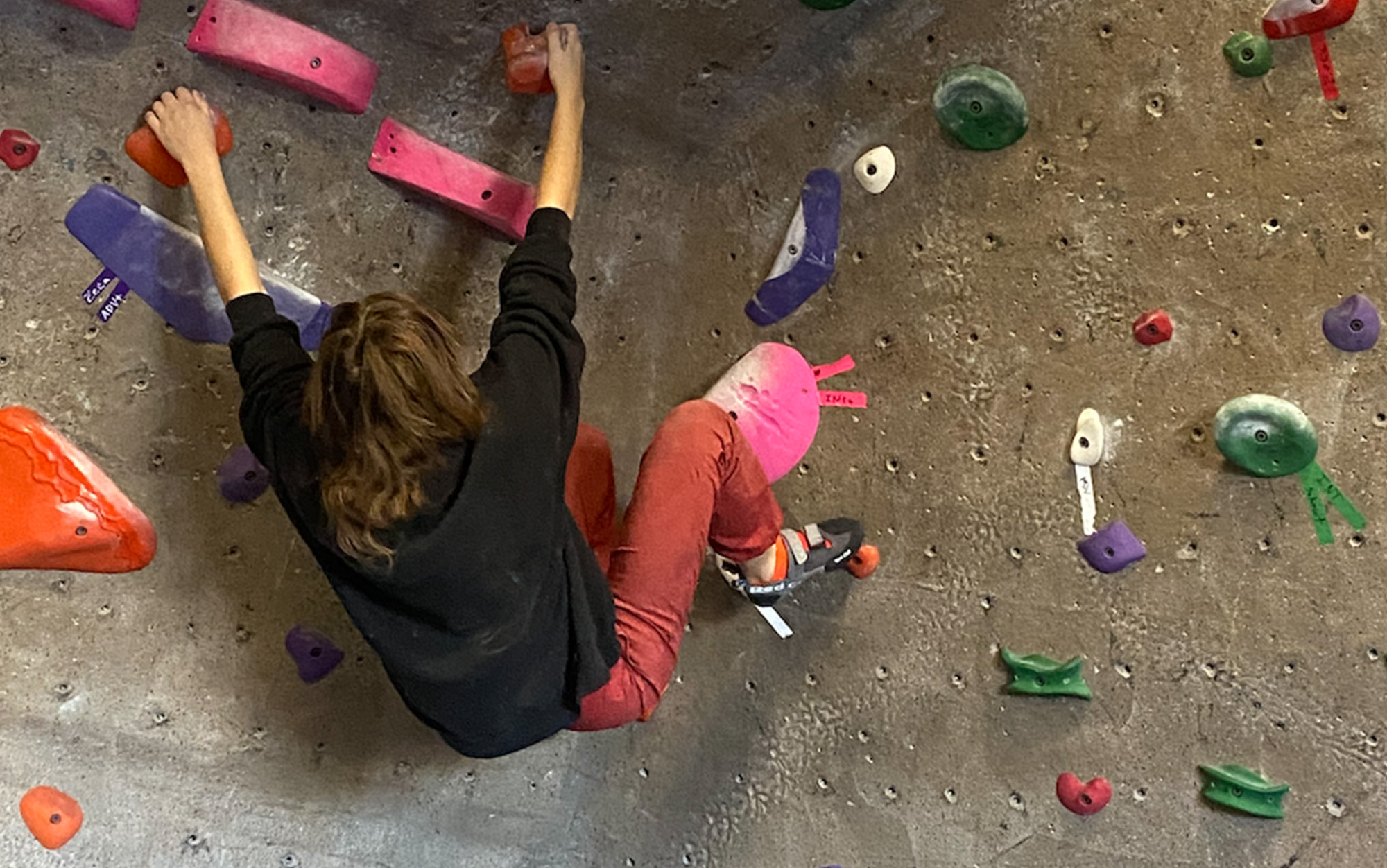
Climbing Style
Your choice of shoe will depend first and foremost on your climbing style. If you’re planning to boulder most of the time, you may prefer a soft, gummy shoe that can handle tiny foot chips and smearing, i.e. pressing your foot against the flat of the wall to gain purchase. If you’re planning on demanding sport climbs with tiny footholds, a stiff, aggressive shoe might be more your speed.
Also consider whether you hope to go indoors or outdoors. Long, multi-pitch trad routes will often demand a comfortable, neutral-shaped shoe that allows you to stand with your foot completely flat. This will allow you to both fit your foot into cracks and take advantage of tiny edges. For hard sport climbs, however, you might prefer something more aggressive — and with velcro closures that are easy to slip on and off between attempts.
Volume of Climbing
If you’re shopping for a special-occasion project shoe, you might not need to pay as much attention to durability. But if you’ve got high-volume gym sessions or long days on rock in your future, do your homework. First, rubber compounds vary widely. Hard rubbers — like Vibram’s XS Edge or Evolv’s Trax XE — tend to be more durable, while soft rubbers — like Vibram’s Grip 2 or Five Ten’s Stealth — will feel stickier on the wall. Keep in mind that softer rubbers wear out faster, which means you’ll need to resole your shoes more often.
Also consider the shoe’s other materials. Soft, squishy shoes tend to have minimal break-in time, but they can wear out faster than stiff-lasted shoes. If you plan to do a ton of climbing — especially outdoors — look for a shoe that’s well-made and has a more durable rubber. Scarpa’s Vapor S, for example, is sturdy and well made and should last season after season. In our experience, Scarpa shoes tend to last longest, closely followed by La Sportiva models.
Also keep in mind your foot shape. Some brands, like Butora, offer shoes in wide or high-volume versions. Other brands, like La Sportiva and Tenaya, tend to cater to a slightly narrower foot shape. The best way to figure out your fit is to go into your local climbing shop and try on as many pairs as possible. Look for a snug fit—you’ll want your toes to touch the end of the shoe, and the heel cup to feel very secure. Looseness in the heel or a baggy fit around the instep can cause your foot to shift and slide, which can make climbing difficult.
FAQs
You don’t need expensive climbing shoes to climb well. The most important thing is that they fit your foot well — snug enough that you can make precise placements, but not so tight that the discomfort is a distraction. That said, if you find a pricey shoe that fits your foot and that’s specifically designed for your favorite type of climbing, the cost can be worth it. Many specialized shoes cost $200 or more these days. But if the shoe is made of durable materials and can withstand a resole (or two or three), you can make it last for a decade or more before it needs to be totally replaced. That makes well-made shoes a worthwhile investment.
Climbing shoe softness is largely a matter of preference. A shoe with a soft midsole or a “split sole” will have more flexibility, which means the shoe will move with the natural flex of your foot. This is ideal if you plan to climb a lot of low-angle or slabby routes and want to be able to press your foot flat against the wall for improved friction. It can also be handy for bouldering, which tends to involve lots of smearing on blank walls or on super tiny feet.
Stiff shoes are the high heels of the climbing world. They’re not comfortable for long periods of time, but they get the job done — and make you feel taller doing it. That’s because they’re rigid enough that they brace your foot whenever you stand on your tippy-toes, allowing you to maximize your vertical reach. Stiff shoes are also great for vertical or overhanging sport routes. They allow you to stand on tiny edges without experiencing foot fatigue, and the claw-like shape can help you gain purchase in roofs.
When some folks get deep into climbing, they get increasingly picky about what shoes they wear. Some elite climbers have up to a dozen pairs of shoes — one for every type of rock, style, and outing. But most climbers tend to just have one or two pairs. If you climb both indoors and outdoors, it may make sense to have a comfortable pair of slip-on climbing shoes for long gym days, and a separate pair of outdoor shoes specially chosen for your preferred climbing style.
Final Thoughts on the Best Climbing Shoes
Modern climbing shoes come with a mind-numbing amount of variability. Choosing the best shoe for your needs will depend on your personal preferences. If you’re looking for a comfortable shoe that will help you start leveling up your gym climbing, the Ocun Jett QC or Butora Acro both offer a great mix of comfort and aggressiveness. If you’re looking for a soft, sticky slipper to wear while bouldering, go for the Scarpa Drago LV.
On the other hand, if you prefer a stiff, aggressive shoe that will let you really milk small edges and claw your way up overhangs, the Red Chili Voltage LV may be your best bet. No matter your goals, be sure to try on several different pairs before you make your final choice. You want a snug fit without serious pain or discomfort. Because, at the end of the day, the best climbing shoe is the one you like wearing.

